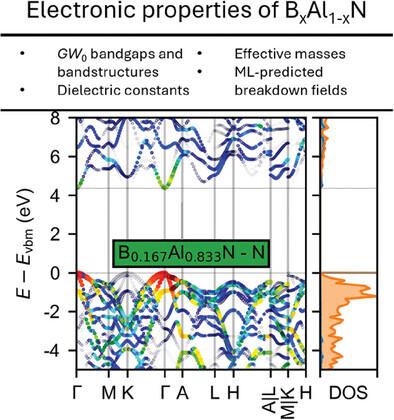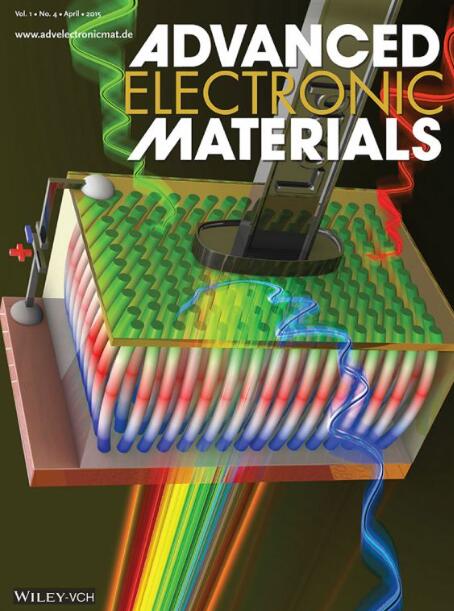Electronic Properties of Ultra-Wide Bandgap BxAl1−xN Computed from First-Principles Simulations
IF 5.3
2区 材料科学
Q2 MATERIALS SCIENCE, MULTIDISCIPLINARY
引用次数: 0
Abstract
Ultra-wide bandgap (UWBG) materials such as AlN and BN hold great promise for future power electronics due to their exceptional properties. They exhibit large bandgaps, high breakdown fields, high thermal conductivity, and high mechanical strengths. AlN and BN have been extensively researched, however, their alloys, BxAl1−xN, are much less studied despite their ability to offer tunable properties by adjusting x. In this article, the electronic properties of 17 recently predicted ground states of BxAl1−xN in the x = 0 − 1 range are predicted using first-principles density functional theory and many-body perturbation theory within GW approximation. All the BxAl1−xN structures are found to be UWBG materials and have bandgaps that vary linearly from that of wurtzite-phase (w) AlN (6.19 eV) to that of w-BN (7.47 eV). The bandstructures of BxAl1−xN show that a direct-to-indirect bandgap crossover occurs near x = 0.25. Furthermore, it is found that BxAl1−xN alloys have much larger dielectric constants than the constituent bulk materials (AlN = 9.3 ɛ0 or BN = 7.3 ɛ0), with values reaching as high as 12.1 ɛ0. These alloys are found to exhibit large dielectric breakdown fields in the range 9–35 MV cm−1 with a linear dependence on x. This work provides the much needed advancement in the understanding of the properties of BxAl1−xN to aid their application in next-generation devices.

通过第一原理模拟计算出的超宽带隙 BxAl1-xN 电子特性
氮化铝(AlN)和硼(BN)等超宽带隙(UWBG)材料因其优异的性能,在未来的电力电子技术领域大有可为。它们具有大带隙、高击穿场、高热导率和高机械强度。本文采用第一原理密度泛函理论和多体扰动理论,在 GW 近似条件下预测了最近预测的 17 种 BxAl1-xN 基态在 x = 0 - 1 范围内的电子特性。研究发现,所有 BxAl1-xN 结构都是 UWBG 材料,其带隙从钨锆相 AlN 的带隙(6.19 eV)到钨锆相 AlN 的带隙(7.47 eV)呈线性变化。BxAl1-xN 的带结构显示,在 x = 0.25 附近出现了直接到间接的带隙交叉。此外,研究还发现 BxAl1-xN 合金的介电常数远大于其组成的块体材料(AlN = 9.3 ɛ0 或 BN = 7.3 ɛ0),介电常数高达 12.1 ɛ0。研究发现,这些合金在 9-35 MV cm-1 范围内表现出很大的介电击穿场,并与 x 呈线性关系。这项工作为了解 BxAl1-xN 的特性提供了亟需的进展,有助于它们在下一代设备中的应用。
本文章由计算机程序翻译,如有差异,请以英文原文为准。
求助全文
约1分钟内获得全文
求助全文
来源期刊

Advanced Electronic Materials
NANOSCIENCE & NANOTECHNOLOGYMATERIALS SCIE-MATERIALS SCIENCE, MULTIDISCIPLINARY
CiteScore
11.00
自引率
3.20%
发文量
433
期刊介绍:
Advanced Electronic Materials is an interdisciplinary forum for peer-reviewed, high-quality, high-impact research in the fields of materials science, physics, and engineering of electronic and magnetic materials. It includes research on physics and physical properties of electronic and magnetic materials, spintronics, electronics, device physics and engineering, micro- and nano-electromechanical systems, and organic electronics, in addition to fundamental research.
 求助内容:
求助内容: 应助结果提醒方式:
应助结果提醒方式:


